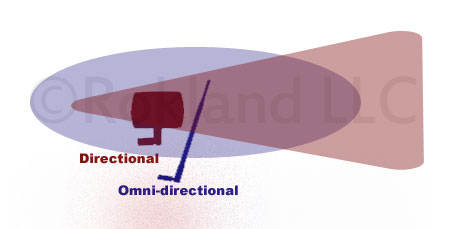The easy way to understand antenna "gain".
The transmitter tries to send Radio Frequency energy out (broadcasting), with the goal of
getting "enough" usable energy to the receiver, usually a very, very small fraction of what
was sent.
For comparisons, a "perfect" theoretical antenna, which radiates all the energy it gets,
and sends all that energy uniformly in ALL directions, is used. Think of a light source
in the center of a sphere, with dim illumination all over the inside surface of the sphere.
DISTANCE: Make the sphere twice (2x) as big, and the inside area of the sphere is FOUR times
larger. With the same energy being sent out to cover the 4-times greater area, the
local brightness is just one quarter of what the surface of the smaller (1x) sphere experienced.
POWER: To make the local brightness on the 2x sphere the same as we had on
the surface of the 1x sphere, we need 4x the power.
The Antenna Gain:
Let's imagine that we put a moderately large flat mirror under the light, reflecting
all (most of) the downward going light upward, then the bottom half of the sphere
goes dark, and the upper half is twice as bright. The mirror is acting as an "antenna"
not wasting the downward light, sending it in a useful direction, thus a 2x "gain"
achieved with "smoke and mirrors", without the smoke.
Armed with this concept, if our receiver was always on one side if us,
we could add a second mirror, vertical, on the side of the light away from the
receiver, and half if the lighted hemisphere would "go dark", and we would
have 4x the light at the receiver. We would have given up the omnidirectional
light radiation for a "directional" illumination. However, we are still lighting
a huge area compared to just lighting the pages of a book that we want to read.
Add more mirrors, shaped somewhat like a dish, and we can easily make the
light on the pages of our book 1000 times brighter, allowing us to read with
only candle power, like a spot light. But, if the book is moving around, we might
have trouble keeping it illuminated by pointing the antenna correctly.
If an antenna does not send out all of the energy, it is said to be mismatched
with the transmitter, or there are other problems, but we will ignore these issues
for the sake of simplicity.
So, sending the energy wisely, in the directions we find useful, without making
the "beam" too narrow or the antenna too large or expensive, is the goal.
A different antenna, like the vertical RC Controller antenna, radiates in all the
sideways directions, but not much up or down. As the antenna gets more
directional (more narrow "beam" or radiation pattern), the effective "brightness"
(RF energy level for the receiver) increases, as long as we keep the receiver
"illuminated".










